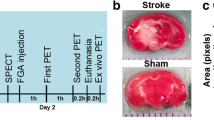Abstract
Current routine clinical techniques, including angiography and perfusional single-photon emission tomography, can be used to indicate problems in cerebral vascular supply and areas of cerebral hypoperfusion following a stroke, but cannot distinguish between ischaemic core and penumbra. In order to image specifically the penumbra, a method or indicator should be able to define areas with reduced blood flow, and a degree of metabolic compromise. In this context, the tissue could be regarded as hypoxic rather than ischaemic, and we have therefore chosen to investigate the potential of radio-labelled hypoxic markers in the study of ischaemia. In order to combine a hypoxic marker with a blood flow marker we used technetium-99m hexamethylpropylene amine oxime (99mTc-HMPAO) and iodine-125 iodoazomycin arabinoside (125I-IAZA), during cerebral ischaemia in the rat middle cerebral artery occlusion model.99mTc-HMPAO and125I-IAZA were injected simultaneously 2 h following occlusion of the middle cerebral artery, and 5 h before decapitation. Paired autoradiograms were produced and compared. Three distinct patterns emerged from the autoradiograms: slightly decreased perfusion with no uptake of the hypoxic marker indicating an area of misery perfusion; moderately decreased perfusion with concomitant uptake of iodoazomycin arabinoside, a region of hypoxia; and severely decreased perfusion with no retention of the hypoxic tracer. In conclusion, we present a new use for an imaging agent in the investigation of cerebral hypoxia. This agent, IAZA together with HMPAO, provides a means of separating the penumbra into regions of misery perfusion and hypoxia. The potential impact of this may be important in the clinical investigation of stroke.
Similar content being viewed by others
References
Chapman JD. Hypoxic sensitisers — implication for radiation therapy.N Engl J Med 1979; 301: 1429–1432.
Hoffman JM. Binding of the hypoxic tracer [3H]misonidazole in cerebral ischaemia.Stroke 1987; 18: 168–176.
Di Rocco RJ, Kuczynski BL, Pirro JP, et al. Imaging ischemic tissue at risk of infarction during stroke.J Cereb Blood Flow Metab 1993; 13: 755–762.
Baron B, Grotta J, Lamki L, Villar C, Ephron V, Patel D, Linder KE, Nunn AD. Preliminary experience with technetium-99m BMS-181321, a nitroimadazole, in the detection of cerebral ischaemia associated with acute stroke.J Nucl Med 1996; 37: 272P.
Yeh SH, Liu RS, Hu HH, Chang CP, Chu LS, Chou KL, Wu LC. Ischaemic penumbra in acute stroke: demonstration by PET with fluorine-18 fluoromisonidazole.J Nucl Med 1994; 35: 205P.
Mannan RH, Somayaji VV, Lee J, Mercer JR, Chapman DJ, Wiebe LI. Radioiodinated 1-(5-iodo-5-deoxy-b-d-arabinofuranosyl)-2-nitroimidazole (iodoazoymicin arabinoside:IAZA): a novel marker of tissue hypoxia.J Nucl Med 1991; 32: 1764–1770.
Groshar D, McEwan AJB, Parliament MB, et al. Imaging tumor hypoxia and tumor perfusion.J Nucl Med 1993; 34: 885–888.
Al-Arafaj A, Ryan EA, Hutchinson K, et al. An evaluation of iodine-123 iodoazomycinarabinoside as a marker of localized tissue hypoxia in patients with diabetes mellitus.Eur J Nucl Med 1994; 21: 1338–1342.
Zea Longa E, Weinstein PR, Carlson S, Cummins R. Reversible middle cerebral artery occlusion without craniectomy in rats.Stroke 1989; 20: 84–91.
Roussel SA, van Bruggen N, King MD, Gadian DG. Identification of collaterally perfused areas following focal cerebral ischaemia in the rat by comparison of gradient echo and diffusion-weighted MRI.J Cereb Blood Flow Metab 1995; 15: 578–586.
Astrup J, Siesjo BK, Symon L. Thresholds in cerebral ischaemia — the penumbra.Stroke 1981; 12: 723–725.
Kinouchi H, Sharp FR, Kotstinaho J, et al. Induction of heat shock HSP70 messenger RNA and HSP70-kDa protein in neurons in the penumbra following focal cerebral ischaemia in the rat.Brain Res 1993; 619: 334–338.
Hossman K-A. Viability thresholds and the penumbra of focal ischaemia.Ann Neurol 1994; 36: 557–565.
Marchal G, Beaudouin V, Rioux P, et al. Prolonged persistence of substantial volumes of potentially viable brain tissue after stroke.Stroke 1996; 27: 599–606.
Back T, Zhao W, Ginsberg M. Three-dimensional image analysis of brain glucose metabolism-blood flow uncoupling and its electrophysiological correlates in the acute ischaemic penumbra following middle cerebral artery occlusion.J Cereb Blood Flow Metab 1995; 15: 566–577.
Lassen NA, Fieschi C, Lenzi GL. Ischaemic penumbra and neuronal death: comments on the therapeutic window in acute stroke with particular reference to thrombolytic therapy.Cerebrovasc Dis 1991; 1: 32–35.
Nunn A, Linder K, Strauss HW. Nitroimidazoles and imaging hypoxia.Eur J Nucl Med 1995; 22: 265–280.
Messa C, Fazio F, Costa DC, Ell PJ. Clinical brain radionuclide imaging studies.Semin Nucl Med 1995; 25: 111–143.
Bowler JV, Wade JPH, Jones BE, Nijran K, Steiner TJ. Single photon emission tomography using hexamethylpropyleneamine oxime in the prognosis of acute cerebral infarction.Stroke 1996; 26: 82–86.
Baron JC. Pathophysiology of acute cerebral ischaemia. PET studies in human.Cerebrovasc Dis 1991; 1 Suppl 1: 22–31.
Matsuda H, Oba H, Seki H, et al. Determination of flow and rate constants in a kinetic model of99mTc hexamethyl propylene amine oxime in the human brain.J Cereb Blood Flow Metab 1988; 8: S51-S68.
Bullock R, Patterson J, Park C. Evaluation of99mTc-hexamethylpropyleneamine oxime cerebral blood flow mapping after acute focal ischaemia in rats.Stroke 1991; 22: 1284–1290.
Lassen NA, Anderson AR, Freiberg L, Paulson OB. The retention of99m-Tc/Dl HMPAO in the human brain after intracarotid bolus injection: a kinetic anlysis.J Cereb Blood Flow Metab 1988; 8: S13-S22.
Hatashita S, Hoff JT. Brain edema and cerebrovascular permeability during cerebral ischaemia in rats.Stroke 1990; 21: 582–588.
Latour LL, Takano K, Formato JE, et al. Diffusion mapping indicates spreading depression significantly increases lesion volume in a rat model of focal ischaemia.Proc ISMRM 1996; 1: 317.
Kohno K, Hoehn-Berlage M, Mies G, Back T, Hossman KA. Relationship between diffusion-weighted MR images, cerebral blood flow and energy state in experiment brain infarction.MRI 1995; 13: 73–80.
Author information
Authors and Affiliations
Rights and permissions
About this article
Cite this article
Lythgoe, M.F., Williams, S.R., Wiebe, L.I. et al. Autoradiographic imaging of cerebral ischaemia using a combination of blood flow and hypoxic markers in an animal model. Eur J Nucl Med 24, 16–20 (1997). https://doi.org/10.1007/BF01728303
Received:
Revised:
Issue Date:
DOI: https://doi.org/10.1007/BF01728303




